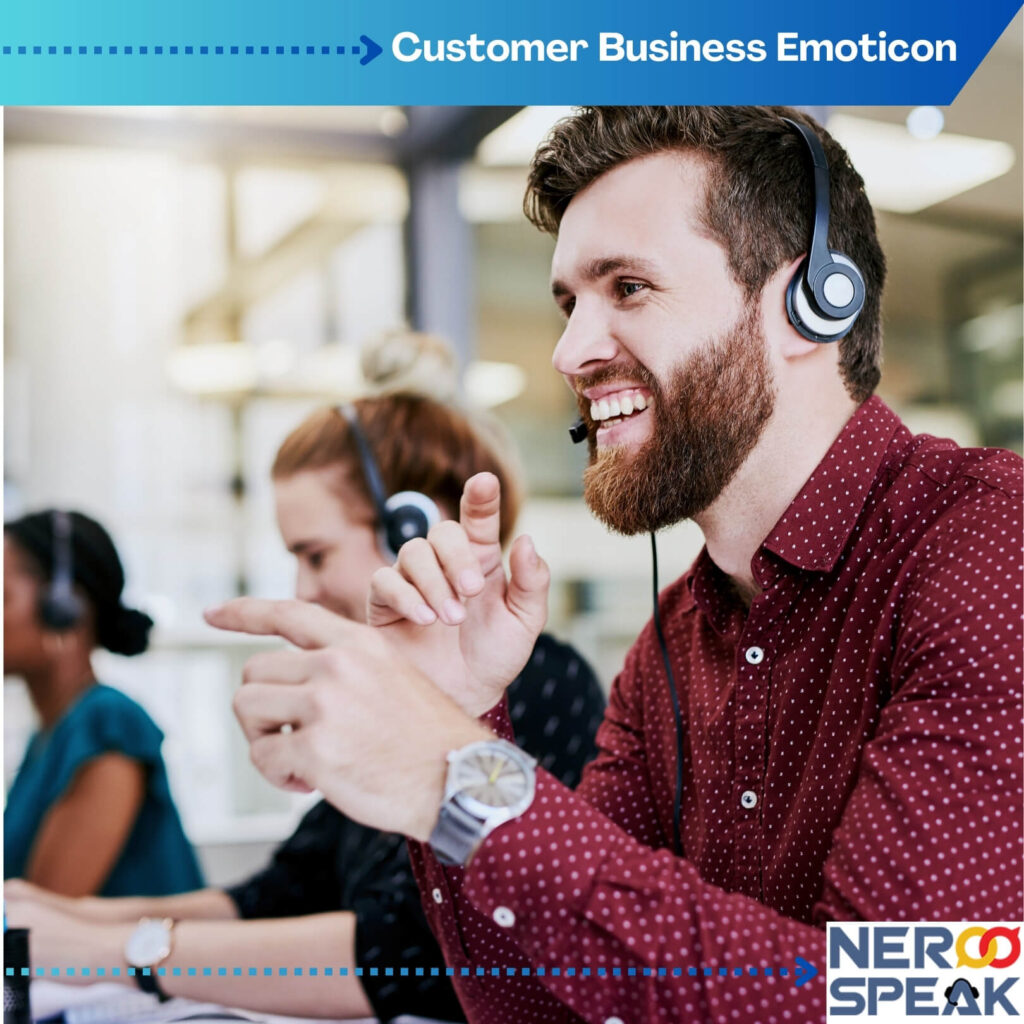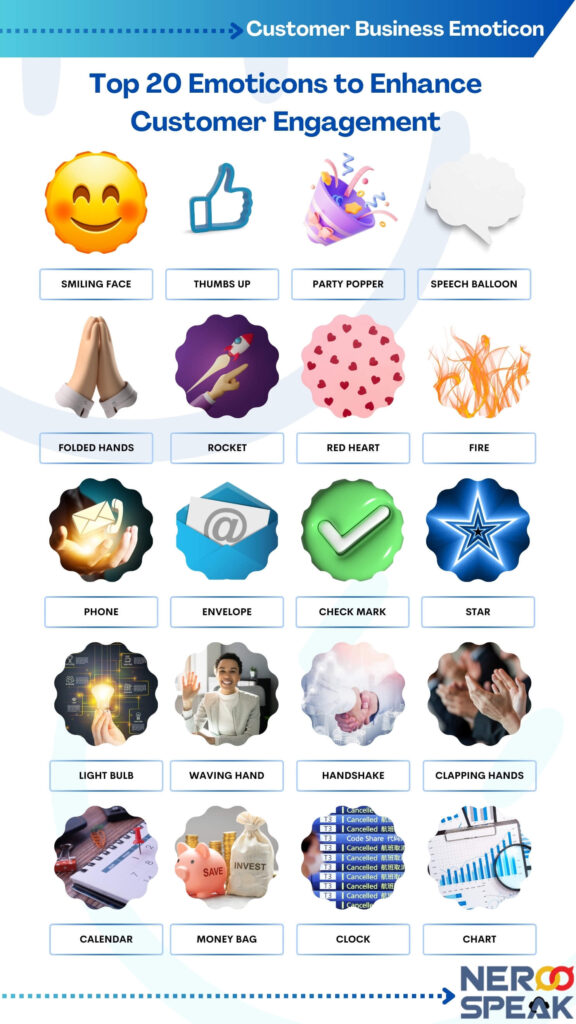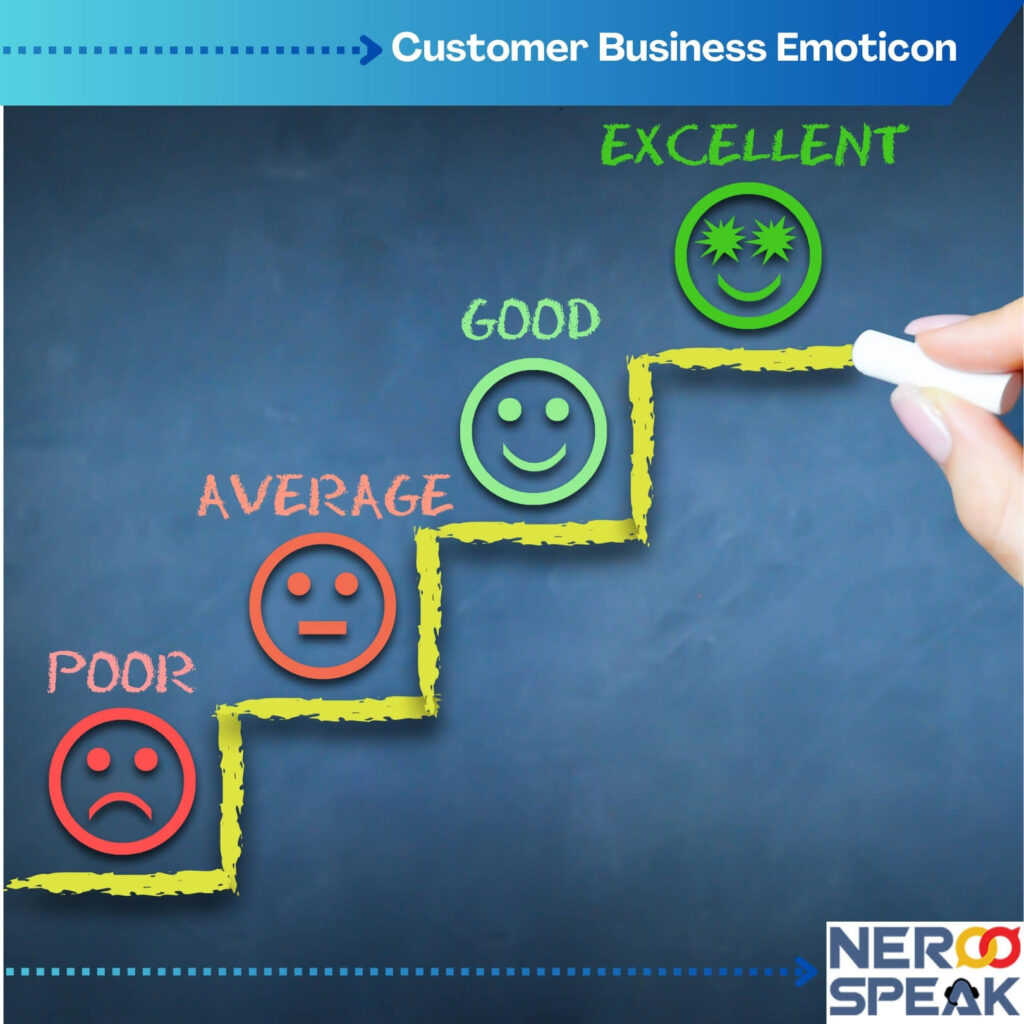“Customer Business Emoticon” means using emoticons in business conversations. This helps companies connect better with their customers.

Understanding the Role of Emoticons in Customer Communication
Emoticons are key to better customer communication. They add feelings to online chats. They help show tone and emotions, which can be tough to express with just text. This can reduce misunderstandings.
When used the right way, emoticons can make messages feel more engaging and easy to connect with. They help build a bond and trust between businesses and their customers. Using emoticons with care can increase customer satisfaction. It can also make a brand feel friendlier and more open.
Read also: Powerful Words for Business Names

Best Ways to Use Emojis in Business Communication
Using customer business emoticons in talks can make communication better. It can help you connect with others. Here are some useful tips:
- Know your audience. Use emoticons that fit what your customer like and what is normal for their culture. This helps ensure your messages are appropriate.
- Use Them Carefully: Emoticons should help the message, not steal the focus. Use them to show clear meaning and feelings, but keep a professional tone.
- Context is key. Use emoticons when you are chatting informally and want to feel friendly. Avoid using them in formal or serious messages.
- Keep a steady use of emoticons that fit your brand’s voice.
By using these tips, businesses can use emoticons. This will help make a friendlier and more welcoming link with customers.
Read also: Best Business English Certificate in 2025
Top 20 Emoticons to Enhance Customer Engagement
Using fun business emoticons can make conversations feel nicer. Here are the top 20 emoticons to help connect better with customers:

- 😊 (Smiling Face) – Friendly and welcoming
- 👍 (Thumbs Up) – Approval or agreement
- 🎉 (Party Popper) – Celebrating milestones
- 💬 (Speech Balloon) – Encouraging feedback
- 🙏 (Folded Hands) – Gratitude or polite request
- 🚀 (Rocket) – Progress or growth
- ❤️ (Red Heart) – Appreciation or love
- 🔥 (Fire) – Excitement or excellence
- 📞 (Phone) – Availability for contact
- 📧 (Envelope) – Email communication
- ✅ (Check Mark) – Task completion
- ⭐ (Star) – Highlighting excellence
- 💡 (Light Bulb) – Ideas or suggestions
- 👋 (Waving Hand) – Greetings or goodbyes
- 🤝 (Handshake) – Partnership or agreement
- 👏 (Clapping Hands) – Praise or congratulations
- 📅 (Calendar) – Scheduling or appointments
- 💰 (Money Bag) – Financial transactions
- 🕒 (Clock) – Time-related information
- 📈 (Chart) – Growth or performance metrics
Read also: Business Words Glossary
Balancing Professionalism and Emoticons in Customer Service
Balancing professionalism with using emojis in customer service needs careful thinking. Emojis can make chats feel warmer and nicer. However, it’s important to use them wisely to maintain a good image.
Choose simple and common emoticons like 😊 (smiling face) or 👍 (thumbs up) to show a positive feel without being too relaxed. Avoid unclear or overly informal emoticons that might confuse people. By using emoticons carefully, businesses can boost customer interaction while maintaining a professional look.

Cultural Sensitivities in Emoticon Usage for Global Customers
When you use business emoticons with customers around the world, think about cultural differences. Emoticons can represent different feelings in various cultures. It is crucial to study and know your audience’s cultural background. This will help you prevent any misunderstandings.
A thumbs up 👍 often means good in many Western cultures. However, in some Middle Eastern countries, it can be considered rude. It’s best to use symbols that everyone understands. Always remember the different customs of your customers. This will help you communicate respectfully. It helps maintain professionalism and build good relationships worldwide.
Read also: Improve Through English Communication Skills Courses
The impact of emoticons on how customers feel and their happiness
- Emoticons help communication. They express tone and feelings. This reduces confusion during conversations with customers.
- Using emoticons makes messages feel more human. It helps digital chatting be friendlier and more engaging.
- Improves Customer Experience: Happy emoticons like 😊 (smiling face) help customers feel valued and listened to.
- Using emoticons wisely can boost customer satisfaction and loyalty.
- Emoticons help to build a friendly link. This can increase trust between the customer and the business.
Using Emoticons in Customer Response Automation
Using customer business emoticons in automated messages can really make the user experience better. It helps make chats feel friendlier and more engaging. Pick emoticons carefully to match the message, like a 😊 for hello or a 👍 for yes.
This method does not only make messages clearer and nicer. It also helps show the right feeling, reducing the chance of being misunderstood. However, ensure that using emoticons matches your brand’s style and is acceptable in the culture to keep things professional and useful.
Read also: I Want to Start A Business But Have No Ideas

Case Studies: Stopping Miscommunication: Using Emoticons Right in Business
- Match Emoticons to Message Tone: Ensure the emoticons in business messages match the overall feel and meaning of the text.
- Know Your Audience: Understand who your customers are. Learn what they like. This will help you choose the right emoticons.
- Cultural Awareness: Know that people may see different meanings in emoticons. This can help you not upset or confuse others.
- Limit Emoticon Use: Use emoticons carefully. This helps keep your message professional and not too crowded.
- Use emoticons in a way that fits your brand’s voice and style.
- Test and Review: Use A/B testing to check how well emoticons help in communication.
- Clear Intentions: Use emoticons to express your feelings. This is important, especially in text that can be difficult to understand.
- Training Staff: Show workers how to use emoticons properly. This will help everyone communicate in the same way.
- Monitor Feedback: Look at customer feedback regularly. This helps spot any issues with how people use emoticons.
- Avoid sensitive topics. Do not use emoticons in serious talks. This helps keep the right tone.
New ways to use emoticons in marketing and customer help.
- Personalize Responses: Use business icons to make automated messages feel more personal.
- Highlight Promotions: Use emojis like 🎉 and 📣 to catch people’s focus on special deals.
- Make Social Media Posts Better: Get more people to respond by using the right emoticons in your social media updates.
- Customer Feedback: Use friendly smiley faces to get feedback. This will make surveys feel simpler.
- Email Marketing: Add emoticons to your subject lines to encourage more people to open your emails.
- Live Chat Support: Use smiley faces to express kindness and friendliness in live support.
- Brand Storytelling: Use emoticons in marketing campaigns to express feelings and enhance storytelling.
- Use emoticons to help make steps in user guides easier to understand.
- Event Announcements: Use fun emojis to make your event alerts stand out.
- Customer Appreciation: Use emoticons in thank-you messages to express your thanks nicely.
We hope you had a good read!!
Browse our website NerooSpeak now and explore more useful articles, for example:
- All About Chief Business Officer (CBO)
- Best Online English Class Recommend
- Improve Your Career by Learning Professional English

Haya Yaseen is a skilled WordPress editor and a dedicated business management specialist. With a keen eye for detail and a passion for crafting engaging digital content, Haya excels in creating and managing professional WordPress websites. She combines her technical expertise with her strong background in business management to deliver innovative and client-focused solutions.
Haya is an alumna of The University of California, Los Angeles (UCLA), where she earned her degree in Business Administration, further refining her skills in strategic thinking and organizational management. Her academic background, paired with her professional experience, makes her a versatile and results-driven individual in the fields of web development and business management.